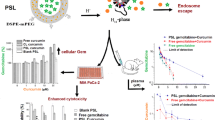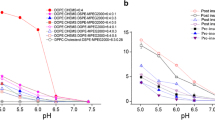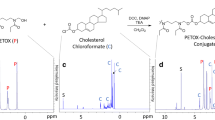Abstract
Purposes
To develop pH-sensitive liposomes (PSL) containing a high content of gemcitabine; and to investigate whether drug loading (DL) would alter the in vitro and pharmacokinetic properties.
Methods
PSL with a high DL were obtained using a modified small-volume incubation method. The DL effects on drug release rate and in vitro cytotoxicity of PSL were evaluated using MIA PaCa-2 pancreatic cancer cells and their pharmacokinetics investigated in rats.
Results
The highest DL of 4.5 ± 0.1% was achieved for gemcitabine in PSL with 145 ± 5 nm diameter. DL did not alter the in vitro release rate from PSL. The IC50 (48 h) of PSL (DL 0.5 and 4.5%) and non pH-sensitive liposomes (NPSL, DL 4.2%) were 1.1 ± 0.1, 0.7 ± 0.1 and 37.0 ± 7.5 μM, respectively. The PSL resulted in a 4.2-fold increase in its elimination half-life (6.2 h) compared to gemcitabine solution (1.4 h) in rats. No significant difference in pharmacokinetic parameters was observed between the two PSL (DL 0.5 and 4.5%).
Conclusion
The PSL offered advantages over NPSL in restoring the sensitivity of pancreatic cancer cells to gemcitabine without requiring a high DL. DL in the PSL did not alter release rate, cytotoxicity or their long-circulating properties.

ᅟ




Similar content being viewed by others
Abbreviations
- ABC transporters:
-
ATP-binding cassette transporters
- CHEMS:
-
Cholesterylhemisuccinate
- DL:
-
Drug loading
- DOPE:
-
1,2-dioleoyl-sn-glycero-3-phosphoethanolamine
- EE:
-
Entrapment efficiency
- EPR:
-
Enhanced permeability and retention
- IC50 :
-
the drug concentration causing 50% inhibition
- MDR:
-
Multi-drug resistance
- NPSL:
-
Non pH-sensitive liposomes
- PC:
-
Pancreatic cancer
- PDI:
-
Polydispersity index
- PEG:
-
Polyethylene glycol
- PSL:
-
pH-sensitive liposomes
- RES:
-
Reticuloendothelial system
- SVI:
-
Small volume incubation
- TEM:
-
Transmission electron microscopy
- TFHE:
-
Thin-film hydration extrusion
REFERENCES
Immordino ML, Dosio F, Cattel L. Stealth liposomes: review of the basic science, rationale, and clinical applications. Existing Potential. 2006;1(3):297–315.
Yin H, Liao L, Fang J. Enhanced Permeability and Retention (EPR) effect based tumor targeting: the concept, application and prospect. JSM Clin Oncol Res. 2014;2(1):1010.
Hilbig A, Oettle H. Gemcitabine in the treatment of metastatic pancreatic cancer. Expert Rev Anticancer Ther. 2008;8(4):511–23.
Xu H, Paxton WJ, Lim J, Li Y, Zhang W, Duxfield L, et al. Development of high-content gemcitabine pegylated liposomes and their cytotoxicity on drug-resistant pancreatic tumour cells. Pharm Res. 2014;31(10):2583–92.
Lee ES, Na K, Bae YH. Doxorubicin loaded pH-Sensitive polymeric micelles for reversal of resistant MCF-7 tumor. J Control Release. 2005;103(2):405–18.
Goren D, Horowitz AT, Tzemach D, Tarshish M, Zalipsky S, Gabizon A. Nuclear delivery of doxorubicin via folate-targeted liposomes with bypass of multidrug-resistance efflux pump. Clin Cancer Res. 2000;6(5):1949–57.
Karanth H, Murthy RS. pH-Sensitive liposomes-principle and application in cancer therapy. J Pharm Pharmacol. 2007;59(4):469–83.
Fattal E, Couvreur P, Dubernet C. “Smart” delivery of antisense oligonucleotides by anionic pH-Sensitive liposomes. Adv Drug Del Rev. 2004;56(7):931–46.
Vanić Z, Barnert S, Süss R, Schubert R. Fusogenic activity of pegylated pH-Sensitive liposomes. J Liposome Res. 2012;22(2):148–57.
Simões S, Slepushkin V, Düzgünes N, de Lima MCP. On the mechanisms of internalization and intracellular delivery mediated by pH-Sensitive liposomes. Biochim Biophys Acta. 2001;1515(1):23–37.
Suzuki R, Takizawa T, Kuwata Y, Mutoh M, Ishiguro N, Utoguchi N, et al. Effective anti-tumor activity of oxaliplatin encapsulated in Transferrin-PEG-Liposome. Int J Pharm. 2008;346(1–2):143–50.
Barenholz Y. Liposome application: problems and prospects. Curr Opin Colloid Interface Sci. 2001;6(1):66–77.
Slepushkin V, Simões S, de Lima MC, Düzgüneş N. Sterically stabilized pH-Sensitive liposomes. Intracellular delivery of aqueous contents and prolonged circulation in vivo. J Biol Chem. 1997;272(4):2382–8.
Hong MS, Lim SJ, Oh YK, Kim CK. pH-Sensitive, serum-stable and long-circulating liposomes as a new drug delivery system. J Pharm Pharmacol. 2002;54(1):51–8.
Simões S, Moreira JN, Fonseca C, Düzgüneş N, de Lima MC. On the formulation of pH-Sensitive liposomes with long circulation times. Adv Drug Deliv Rev. 2004;56(7):947–65.
Leite EA, Souza CM, Carvalho-Júnior AD, Coelho LG, Lana AM, Cassali GD, et al. Encapsulation of cisplatin in long-circulating and pH-Sensitive liposomes improves its antitumor effect and reduces acute toxicity. Int J Nanomedicine. 2012;7:5259–69.
Mo R, Sun Q, Li N, Zhang C. Intracellular delivery and antitumor effects of pH-Sensitive liposomes based on zwitterionic oligopeptide lipids. Biomaterials. 2013;34(11):2773–86.
Toschi L, Finocchiaro G, Bartolini S, Gioia V, Cappuzzo F. Role of gemcitabine in cancer therapy. Future Oncol. 2005;1(1):7–17.
Manuel H. Pancreatic Cancer. N Engl J Med. 2010;362:1605–17.
Jemal A, Siegel R, Ward E, Hao Y, Xu J, Murray T, et al. Cancer statistics, 2008. CA Cancer J Clin. 2008;58(2):71–96.
Touroutoglou N, Gravel D, Raber MN, Plunkett W, Abbruzzese JL. Clinical results of a pharmacodynamically-based strategy for higher dosing of gemcitabine in patients with solid tumors. Ann Oncol. 1998;9(9):1003–8.
Storniolo AM, Allerheiligen SR, Pearce HL. Preclinical, pharmacologic, and Phase I studies of gemcitabine. Semin Oncol. 1997;24(2 Suppl 7):S7-2–7.
Kiani A, Köhne CH, Franz T, Passauer J, Haufe T, Gross P, et al. Pharmacokinetics of gemcitabine in a patient with end-stage renal disease: effective clearance of its main metabolite by standard hemodialysis treatment. Cancer Chemother Pharmacol. 2003;51(3):266–70.
Kuenen BC, Rosen L, Smit EF, Parson MR, Levi M, Ruijter R, et al. Dose-finding and pharmacokinetic study of cisplatin, gemcitabine, and Su5416 in patients with solid tumors. J Clin Oncol. 2002;20(6):1657–67.
Lee RJ, Low PS. Folate-mediated tumor cell targeting of liposome-entrapped doxorubicin in vitro. Biochim Biophys Acta. 1995;1233(2):134–44.
Ogawara K, Un K, Minato K, Tanaka K, Higaki K, Kimura T. Determinants for in vivo anti-tumor effects of peg liposomal doxorubicin: importance of vascular permeability within tumors. Int J Pharm. 2008;359(1–2):234–40.
Elzainy AA, Gu X, Simons FE, Simons KJ. Hydroxyzine- and cetirizine-loaded liposomes: effect of duration of thin film hydration, freeze-thawing, and changing buffer pH on encapsulation and stability. Drug Dev Ind Pharm. 2005;31(3):281–91.
Szoka F, Papahadjopoulos D. Procedure for preparation of liposomes with large internal aqueous space and high capture by reverse-phase evaporation. Proc Natl Acad Sci U S A. 1978;75(9):4194–8.
Zhang W, Wang G, Falconer JR, Baguley BC, Shaw JP, Liu J, et al. Strategies to maximize liposomal drug loading for a poorly water-soluble anticancer drug. Pharm Res. 2015;32(4):1451–61.
Zhigaltsev IV, Maurer N, Akhong QF, Leone R, Leng E, Wang J, et al. Liposome-encapsulated vincristine, vinblastine and vinorelbine: a comparative study of drug loading and retention. J Control Release. 2005;104(1):103–11.
Costa P. An alternative method to the evaluation of similarity factor in dissolution testing. Int J Pharm. 2001;220(1–2):77–83.
Xu H, Paxton JW, Lim J, Li Y, Wu Z. Development of a gradient high performance liquid chromatography assay for simultaneous analysis of hydrophilic gemcitabine andlipophilic curcumin using a central composite design and its application in liposome development. J Pharm Biomed Anal. 2014;98:371–8.
Xu H, Paxton JW, Wu Z. Enhanced pH-Responsiveness, cellular trafficking, cytotoxicity and long-circulation of PEGylated liposomes with post-insertion technique using gemcitabine as a model drug. Pharm Res. 2015;32(7):2428–38.
Working PK, Newmanl MS, Huang SK, Mayhew E, Vaage J, Lasicl DD. Pharmacokinetics, biodistribution and therapeutic efficacy of doxorubicin encapsulated in stealth liposomes (Doxil). J Liposome Res. 1994;4:667–87.
Paliwal SR, Paliwal R, Vyas SP. A review of mechanistic insight and application of Ph-Sensitive liposomes in drug delivery. Drug Deliv. 2014;22(3):231–42.
Hafez IM, Cullis PR. Cholesteryl hemisuccinate exhibits PH sensitive polymorphic phase behavior. Biochim Biophys Acta. 2000;1463(1):107–14.
Kim IY, Kang YS, Lee DS, Park HJ, Choi EK, Oh YK, et al. Antitumor activity of Egfr targeted Ph-Sensitive immunoliposomes encapsulating gemcitabine in A549 xenograft nude mice. J Control Release. 2009;140(1):55–60.
Graeser R, Bornmann C, Esser N, Ziroli V, Jantscheff P, Unger C, et al. Antimetastatic effects of liposomal gemcitabine and empty liposomes in an orthotopic mouse model of pancreatic cancer. Pancreas. 2009;38(3):330–7.
Cosco D, Bulotta A, Ventura M, Celia C, Calimeri T, Perri G, et al. In vivo activity of gemcitabine-loaded pegylated small unilamellar liposomes against pancreatic cancer. Cancer Chemother Pharmacol. 2009;64(5):1009–20.
Kirkham M, Parton RG. Clathrin-independent endocytosis: new insights into caveolae and non-caveolar lipid raft carriers. Biochim Biophys Acta. 2005;1745(3):273–86.
Huang RB, Mocherla S, Heslinga MJ, Charoenphol P, Eniola-Adefeso O. Dynamic and cellular interactions of nanoparticles in vascular-targeted drug delivery. Mol Membr Biol. 2010;27(4–6):190–205.
Maruyama K. Intracellular targeting delivery of liposomal drugs to solid tumors based on EPR effects. Adv Drug Deliv Rev. 2011;63(3):161–9.
Fenske DB, Cullis PR. Liposomal Nanomedicines. Expert Opin Drug Deliv. 2008;5(1):25–44.
Cui J, Li C, Guo W, Li Y, Wang C, Zhang L, et al. Direct comparison of two pegylated liposomal doxorubicin formulations: is AUC predictive for toxicity and efficacy? J Control Release. 2007;118:204–15.
Paolino D, Cosco D, Racanicchi L, Trapasso E, Celia C, Iannone M, et al. Gemcitabine-loaded pegylated unilamellar liposomes vs Gemzar®: biodistribution, pharmacokinetic features and in vivo antitumor activity. J Control Release. 2010;144:144–50.
ACKNOWLEDGMENTS AND DISCLOSURES
The financial support for this study was provided by a Marsden Fund by the Royal Society of New Zealand (Grant number UOA1201) and an Auckland Medical Research Fund (Grant Number 1113026). We also thank Mr Alan Gall from VJU for his technical support with the animal studies. Hongtao Xu also wishes to acknowledge the support of a Doctorial Scholarship provided by The University of Auckland, New Zealand.
Author information
Authors and Affiliations
Corresponding author
Ethics declarations
Conflict of Interest
The authors declare that they have no conflicts of interest to disclose.
Rights and permissions
About this article
Cite this article
Xu, H., Paxton, J.W. & Wu, Z. Development of Long-Circulating pH-Sensitive Liposomes to Circumvent Gemcitabine Resistance in Pancreatic Cancer Cells. Pharm Res 33, 1628–1637 (2016). https://doi.org/10.1007/s11095-016-1902-8
Received:
Accepted:
Published:
Issue Date:
DOI: https://doi.org/10.1007/s11095-016-1902-8




